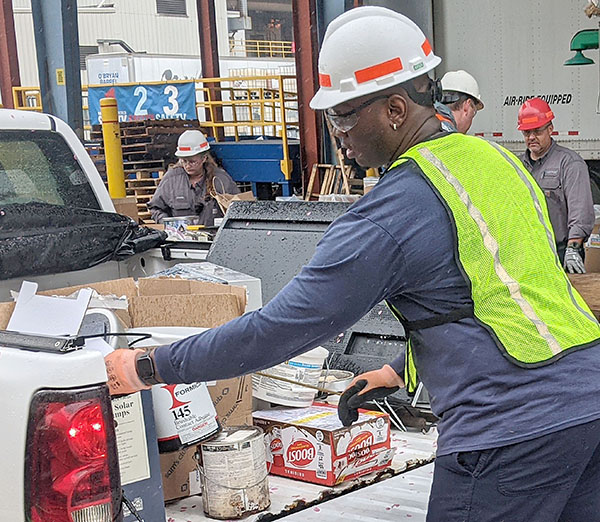We first distributed this blog in November of 2014, but it has continued to be helpful and useful and wanted to share it with you again! Hazardous waste generators are under constant scrutiny to avoid violating regulations set by RCRA as well as national and state government. In order to help you avoid any potential violations we have developed the following list of 10 steps. If you manage your waste with these ten things in mind you should be able to maintain a safe and compliant workplace.
1. Remember to mark storage containers with an accumulation date.
Containers of hazardous waste in a 90 or 180-day storage area must be marked with an accumulation date. Check that yours are each week during your inspection of the storage area. You could also consider using a log or spreadsheet to track wastes in addition to review of dates during your area inspections.
2. Make sure used oil containers are properly labeled.
Remember, “Used oil is defined as any oil that was refined from crude oil or any synthetic oil, and that is used and as a result of such use is contaminated by physical or chemical impurities.” Any container holding used oil must be marked “Used Oil.” Additionally, pipes used to transfer used oil to a UST must be marked “Used Oil.”
3. Ensure that your containers are kept closed.
Except in the instances of adding or removing waste containers should always remain closed. This means closing and latching funnels, screwing in bungs, using drum rings, and tightening bolts. Remember, if the contents would spill if the container was overturned, then the container is considered open.
4. Keep tabs on your universal wastes.
Make sure you understand the regulations for universal wastes (things like batteries and used lamps). Properly label the wastes as “Universal Waste Batteries” and “Universal Waste Lamps.” Check your local state regulations as well.
5. Label all containers in your storage areas.
Containers in a 90 or 180-day storage area must be marked with the words “Hazardous Waste” as well as listing: generator name and address, accumulation start date, contents, physical state, and hazardous properties.
6. Have a contingency plan in place.
Whether you’re a small quantity or large quantity generator, you must have a contingency plan in place. You can help make sure you avoid violations by designating an emergency coordinator, keeping information up to date and on-site, ensuring all required elements are included in your plan, and for LQG’s, document submittals to local authorities.
7. Have a hazardous waste reduction plan on-site.
A hazardous waste reduction plan (often referred to as a waste minimization plan) is required for all hazardous waste generators. To keep yourself compliant make sure you keep a copy on-site, update that copy annually to ensure accuracy, make sure it’s signed by management, and ensure all applicable elements are included.
8. Properly label waste in satellite accumulation areas.
Utilizing satellite accumulation areas can be very beneficial to hazardous waste generators but it is imperative that all requirements listed in 40CFR are followed. Keep yourself violation free by reviewing and understanding the definition of a satellite accumulation area and by labeling your container once the first drop of hazardous waste is added.
9. Perform weekly inspections of hazardous waste storage areas.
Ensure consistency in your inspections by designating one day a week to perform them. Remember that Monday’s and Friday’s are not typically the best choices since they are often spent catching up from the weekend or readying for the weekend respectively. Have a back-up inspector and make sure that all inspections are documented in an inspection log.
10. Always make a hazardous waste determination.
You must make a hazardous waste determination for all wastes generated on your site. You should also make a list of each kind of hazardous waste generated. Determine if any exemptions apply to your wastes and figure out if your wastes are listed or characteristic hazardous wastes. Treat any unknown waste as hazardous until a determination has been made. Document everything and hold on to the documentation.
More News From Heritage
-
6/27/24
Heritage Environmental Services to Acquire EBV from General Dynamics
Heritage Environmental Servicess, an EQT Infrastructure portfolio company, will acquire EBV from General Dynamics
-
6/13/24
Meet The Facilities – East Liverpool
An inside look at our incineration facility located in East Liverpool, OH
-
5/24/24
Habitat for Humanity 2024
Heritage hosted our 14th annual Habitat for Humanity build this month, partnering with over 50 employees from various THG companies.
-
5/6/24
Date set for the household hazardous waste collection in East Liverpool, Ohio
-
3/12/24
Equal Pay Day – Spotlighting Our Female Drivers
-
3/8/24
International Women’s Week Spotlight – Shannon Dippel
For International Women's Week, we're spotlighting some of the incredible women in the Heritage family. Our final spotlight is Shannon Dippel.
-
3/8/24
International Women’s Week Spotlight – Susan Adams
For International Women's Week, we're spotlighting some of the incredible women in the Heritage family. Our sixth spotlight is Susan Adams.
-
3/7/24
International Women’s Week Spotlight – Lea Wilson
For International Women's Week, we're spotlighting some of the incredible women in the Heritage family. Our fifth spotlight is Lea Wilson








